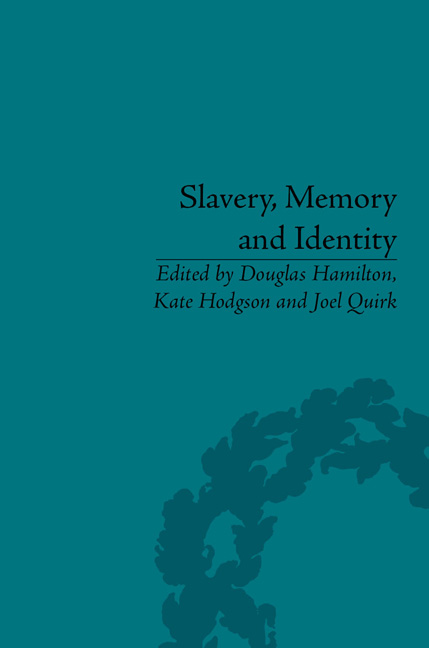Book contents
- Frontmatter
- CONTENTS
- Acknowledgements
- List of Contributors
- Introduction: Slavery, Memory and Identity: National Representations and Global Legacies
- 1 ‘A Thoroughly National Work’: The Politics of Blame and European Abolitionist Identities
- 2 From Slave Quarters to Wigwams: Native American Slaveholding and the Debate over Civilization
- 3 For Civilization's Sake: Legal Abolition of Slavery in Nepal and Sierra Leone in a Global Perspective, 1920–30
- 4 The Heritage of Slavery and Nation Building: A Comparison of South Africa and Mauritius
- 5 Picturing Slavery: The Perils and Promise of Representations of Slavery in the United States, the Bahamas and England
- 6 ‘History Must be Re-Written!’: Revisionist Ambitions among West African Slave Descendants
- 7 Contrapuntal Memories of Slavery and Abolition in the French-Speaking World
- 8 Public Memory of Slavery in Brazil
- 9 Learning to Remember and Imagine Slavery: The Pedagogies of Museum Field Trips in the Representation of ‘Difficult’ Histories
- 10 Slavery and Racism as the ‘Wrongs’ of (European) History: Reflections from a Study on Portuguese Textbooks
- Notes
- Index
2 - From Slave Quarters to Wigwams: Native American Slaveholding and the Debate over Civilization
- Frontmatter
- CONTENTS
- Acknowledgements
- List of Contributors
- Introduction: Slavery, Memory and Identity: National Representations and Global Legacies
- 1 ‘A Thoroughly National Work’: The Politics of Blame and European Abolitionist Identities
- 2 From Slave Quarters to Wigwams: Native American Slaveholding and the Debate over Civilization
- 3 For Civilization's Sake: Legal Abolition of Slavery in Nepal and Sierra Leone in a Global Perspective, 1920–30
- 4 The Heritage of Slavery and Nation Building: A Comparison of South Africa and Mauritius
- 5 Picturing Slavery: The Perils and Promise of Representations of Slavery in the United States, the Bahamas and England
- 6 ‘History Must be Re-Written!’: Revisionist Ambitions among West African Slave Descendants
- 7 Contrapuntal Memories of Slavery and Abolition in the French-Speaking World
- 8 Public Memory of Slavery in Brazil
- 9 Learning to Remember and Imagine Slavery: The Pedagogies of Museum Field Trips in the Representation of ‘Difficult’ Histories
- 10 Slavery and Racism as the ‘Wrongs’ of (European) History: Reflections from a Study on Portuguese Textbooks
- Notes
- Index
Summary
In the revised and expanded second edition of his 1839 book, A View of the Action of the Federal Government, in Behalf of Slavery, abolitionist jurist William Jay introduced a number of important topics that had not appeared in the original edition. In one new section, ‘Intercourse of the Government with the Indians Made Sueservient [sic] to Slavery’, Jay illuminated for his anti-slavery readers how the United States government acted on behalf of American slave-holders whose slaves had taken refuge among southern Indians during wartime. Jay showed that such efforts usually took the form of treaty clauses ‘for the surrender of prisoners’, white and black. But he disputed the entire foundation upon which these clauses rested, which assumed that Indians captured and held blacks against their will: ‘It is doubtful whether the southern Indians, in their wars, made any slaves prisoners, strictly speaking.’ The real issue, Jay asserted, was that slaves willingly left their white masters to live among Indians:
Servitude with the Indians is so much lighter than with the planters, that the slaves are ever ready to exchange Christian for heathen masters; and many of them have embraced the opportunity, afforded by Indian wars, of escaping from the ‘quarters,’ and seeking refuge in the wigwam.
It may be rather surprising to see an abolitionist like William Jay making statements about benign slavery and benevolent masters, given his commitment to the principles of radical anti-slavery, but such rhetoric was by no means unusual. Similar statements about benevolent Indian masters and the preference of black slaves for Indian masters appeared in a number of anti-slavery speeches and writings from the 1830s through the 1850s. Abolitionists made an exception for Indian slaveholders, not only accepting the widespread view that slavery among Indians was different than among whites, but also exempting Indian slaveholders from moral censure. This essay seeks to answer why abolitionists believed that Indians were benevolent masters, and to what ends they put this romanticized picture of Indian slaveholding.
- Type
- Chapter
- Information
- Slavery, Memory and IdentityNational Representations and Global Legacies, pp. 29 - 44Publisher: Pickering & ChattoFirst published in: 2014



